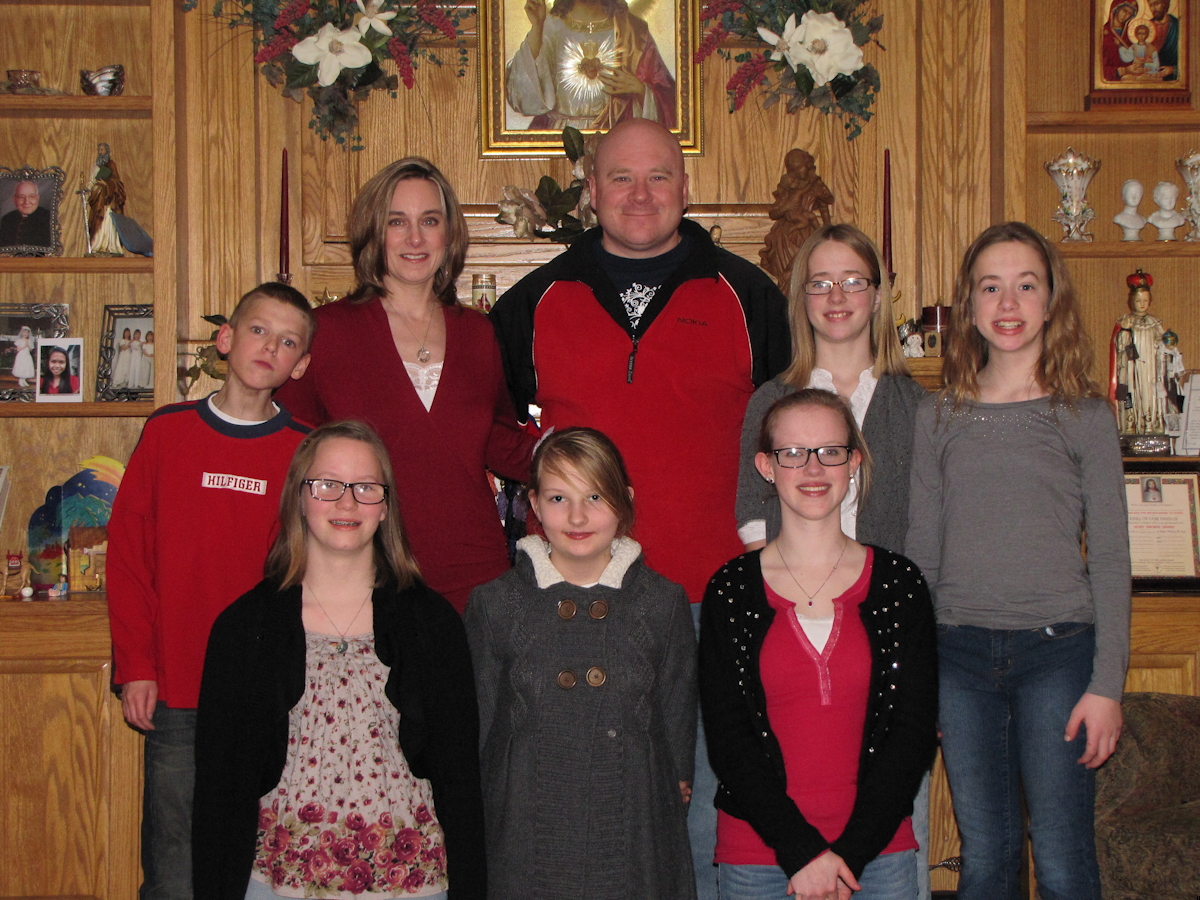What the Church teaches on the moral spacing and limiting of births by spouses
Catholic spouses who strive to live Church teaching on responsible parenthood are sometimes confused by what the Church means by “serious” or “grave” reasons for the use of Natural Family Planning (NFP). This article will address that issue.
NFP enables spouses to space births according to the naturally occurring phases of fertility and infertility in the menstrual cycle. The Church has accepted this innovation of the 20th century as a morally acceptable means of spacing and limiting births in married life. The contemporary Church document, Humanae vitae, which articulated the reasons why NFP is acceptable, uses the words “serious” and “grave” to indicate the distinctions which spouses need to consider as they seek to plan their families according to God’s will. Catholic couples need to understand the meaning behind these words.
Historical Overview
The Church has always recognized the legitimacy of abstaining from sexual intercourse when both spouses consent for a limited time and for religious reasons (cf. 1 Cor. 7:5). When Pius XI condemned contraception in his encyclical on marriage, Casti connubii (Dec 31, 1930), he did not address the licitness of the Rhythm method which had only recently been discovered but did allow married couples the use of their conjugal rights “in the proper manner” when new life could not be brought forth either because of timing or defects of nature (no. 59). It was not until Pius XII that explicit pronouncements were made. By that time the Basal Body Temperature method (BBT) was becoming increasingly known and used among Catholics.
Pius XII, in an address to Italian midwives in October 1951, declared licit the use of the sterile period for serious reasons, but if the couple was confining intercourse to those days exclusively, their conduct needed to be examined. In that case it was not enough to be ready to accept a pregnancy if one should occur. For the practice to be moral there must be serious reasons independent of the couple’s good will. Otherwise to do so “would be a sin against the very meaning of conjugal life.” At the same time, Pius XII advised midwives to obtain a thorough knowledge of the biological and technical aspects of the theory.
Among the serious reasons for use even for an indefinite period, Pius XII cited “medical, eugenic, economic and social implication.” [1] Only one month later in another address, the pope affirmed “the legitimacy and, at the same time, the limits–in truth very wide–of a regulation of offspring, which unlike so-called ‘birth control,’ is compatible with the law of God,” and he hoped that science would provide a more secure basis for the method. [2]
The advent of the anovulant pill in the 1960’s and pressure from within the Church itself to change its teaching on contraception in the name of enhancing the unitive dimension of marriage led to lively debates in Vatican Council II. While Pope Paul VI reserved the question of whether the anovulant pill was a contraceptive until after the Council, the pastoral constitution on the Church in the modern world, Gaudium et Spes, reaffirmed that “marriage and conjugal love are by their nature ordered to the procreation and education of children” (no. 48), and that the aim and meaning of conjugal life is to cooperate with the Creator in enlarging God’s family. As cooperators with the Creator they are “interpreters of his love” (no. 50).
Spouses will thoughtfully take into account both their own welfare and that of their children, those already born and those which may be foreseen. For this accounting they will reckon with both the material and spiritual conditions of the times as well as of their state of life. Finally they will consult the interests of the family group, of temporal society and of the Church herself (See GS, no.50).
Grave and Serious
Paul VI in his encyclical Humanae vitae (1968), while condemning the use of all contraceptive methods for even grave (gravia) reasons, declared licit the recourse to the infertile periods if the spouses have good (just and seria) reasons to postpone even indefinitely another pregnancy (HV, no.16 &10; the language here is similar to Gaudium et Spes, no.10). But first those spouses are commended who, with prudent deliberation and generosity, choose to accept a large family. The spouses are to consider their responsibilities towards God, themselves, the family, and human society. Each of these factors may be taken into account in right order in determining “serious and just reasons.”
In other words, the spouses are to discern together first, what is God’s plan for their family here and now, then their own physical and emotional resources for accepting another child, the needs of other family members, and lastly the good of the human society in which they live. The pope gives special encouragement to scientists to perfect the natural methods (HV, no.24), declaring that the discipline of chastity exercised in periodic continence enhances married life provided the spouses value the true blessings of family (HV, no.21).
John Paul II
John Paul II is faithful to the guidelines of Humanae vitae. In the Apostolic Exhortation, Familiaris consortio, he calls the fundamental task of the family “to serve life, to actualize in history the original blessing of the Creator–of transmitting by procreation the divine image from person to person” (FC, no.28). The Holy Father praises large families [3]; however, he also states,
. . . the fruitfulness of conjugal love is not restricted solely to the procreation of children…it is enlarged and enriched by all those fruits of moral, spiritual and supernatural life which the father and mother are called to hand on to their children, and through the children to the Church and to the world. (FC, no.28)
John Paul II takes every opportunity to encourage the development of NFP as a way of spacing births. [4] “When,” he says “by means of recourse to the periods of infertility, the couple respect the inseparable connection between the unitive and procreative meanings of human sexuality, they are acting as ‘ministers’ of God’s plan” (FC, no.32). John Paul II is at pains to counter those who would interpret too narrowly the Church’s teaching on the licitness of natural methods, adopting a form of providentialism, citing both Gaudium et spes no. 50 and Humanae vitae no.10: God the Creator invites the spouses not to be passive operators, but rather ‘cooperators or almost interpreters’ of His plan. [5]
The spouses are to exercise the virtue of prudence in a considered assessment of the well-being of the whole family. Reason and will are not to be abandoned in favor of a passive submission to physiological processes. Husband and wife are called to stewardship of all their gifts, especially fertility, which concerns the birth of a new human person made in the image of God and destined to union with Him for all eternity.
NFP proponent Rev. Anthony Zimmerman likens the spouses’ co-creation to God’s creation of the world in Genesis (1:1 to 2:3). After each new creation, God “saw that it was good” and paused before a new act of creation. After making man and women on the sixth day, he declared everything “very good” and rested from further creation. In the same way, NFP parents pause between each birth and when their family is complete according to God’s plan for them (which is likely to vary with each family), rest from any further work of co-creation. [6]
More than his predecessors, John Paul II saw the benefits of natural methods to the couple and family. He appreciates the way they offer spouses the possibility not only to space children but also to identify the most opportune time to conceive a child. In addition they call for dialogue and mutual sensitivity to one another. “Thus,” he says, “periodic continence…requires a profound understanding of the person and love.”
The way of living which follows from the exercise of periodic continence leads the couple to deepen their knowledge of each other and achieve a harmony of body, mind and spirit which strengthens and encourages them on their journey together through life. It is marked by a constant dialogue and enriched by the tenderness of affection which constitutes the heart of human sexuality. [7]
A Final Word
In summary, all the papal documents addressing the issue of marriage and procreation in the 20th century affirm that marriage and conjugal love are ordered to the procreation and education of children. While contraception cannot be used even in grave circumstances, natural methods of fertility regulation are licit when the couple have serious reasons. Children are a gift to be joyfully received as the crowning glory of family life (GS, no. 48). All modern popes have endorsed the development and use of natural methods of family planning as an aid to living responsible parenthood. John Paul II especially sees them as enabling the spouses to become a total gift to one another.
Notes
[1] Pius XII, Moral Questions Affecting Married Life: Addresses given October 29, 1951 to the Italian Catholic Union of midwives and November 26, 1951 to the National Congress of the Family Front and the Association of Large Families, National Catholic Welfare Conference, Washington, DC.
[2] Ibid
[3] John Paul II, “Homily at Capitol Mall, Oct 7, 1979,” in Pilgrim of Peace: Homilies and Addresses of his Holiness, Pope John Paul II on the Occasion of his Visit to the United States, USCC, 1979: 175-179.
[4] See, for example, “Pope to Two International Groups of Researchers,” L’Osservatore Romano (Weekly Edition) Dec. 3, 1979, and “To Study Group on Natural Regulation of Fertility: The Church is Grateful for the help you offer married couples,” L’Osservatore Romano, July 12, 1982.
[5] “Papal audience to participants of NFP course in Rome, December 14, 1990,” L’Osservatore Romano (weekly edition) Dec. 17, 1990.
[6] Rev. Anthony Zimmerman, “Newlyweds and NFP,” Homiletic and Pastoral Review, October 1986, 21-31.
[7] Address to “The Natural Regulation of Fertility: The Authentic Alternative,” conference, Rome, Dec. 9-11, 1992.
Copyright © 1999, Diocesan Development Program for Natural Family Planning, National Conference of Catholic Bishops (United States Conference of Catholic Bishops). Used with permission on dev19.foryourmarriage.org.






